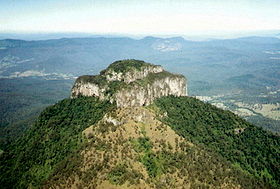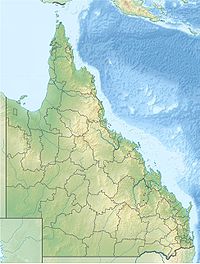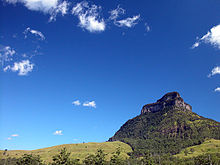- Mount Lindesay (Queensland)
-
Mount Lindesay 
The distinctly shaped peak of Mount LindesayElevation 1,177 m (3,862 ft) Location Queensland, Australia Range McPherson Range Coordinates 28°30′38″S 152°43′21″E / 28.51056°S 152.7225°ECoordinates: 28°30′38″S 152°43′21″E / 28.51056°S 152.7225°E Climbing First ascent 1872 Mount Lindesay lies on the Queensland-New South Wales border, approximately 140 km south west of Brisbane, Australia. It is one of a number of peaks in the McPherson Range, and is remarkable for its tiered summit, the eroded remnant of lava flows from the nearby Focal Peak shield volcano.[1] Mount Lindesay is situated within the Mount Barney National Park in Queensland and the Border Ranges National Park in New South Wales. Apart from the northern slopes, the rest of the peak is covered in dense rainforest, and the summit is frequently in cloud and mist. The Mount Lindesay Highway passes to the western side of Mount Lindesay.
Mount Lindesay has been part of a successful native title claim made by the Githabul people,[2] for whom the peak holds a special significance.
Climbing
Despite appearances, Mount Lindesay offers few opportunities for rock-climbers, due to the unsound nature of the rock (decaying rhyolite). There is one steep and exposed scrambling route to the summit, rated at approximately grade 6-7, which starts at the south east corner of the upper cliffs. However, this is not a bushwalking route as such, and anyone making an ascent should have basic rock-climbing and abseiling skills, or be under the guidance of experienced rock-climbers.[3]
The first recorded ascent of Mount Lindesay by Europeans was made in May 1872, by Thomas de Montmorency Murray-Prior (1848-1902) and Phillip Walter Pears (1846-1924). At the time of the 1872 ascent, an Aboriginal elder at nearby Unumgar station informed Pears that his father had once climbed the peak, which suggests that Aboriginal people have made occasional ascents of Mount Lindesay for thousands of years.[4]
The second recorded ascent of Mount Lindesay by Europeans was made in July 1890, by the Norwegian naturalist and explorer Carsten Egeberg Borchgrevink (1864-1934), then working in the district as a surveyor's labourer, and Edwin Villiers-Brown, of Beaudesert. There were a further eight recorded ascents by the late 1920s, when pioneering climbers such as Bert Salmon (1899-1982) started visiting the peak regularly. The first women to climb Mount Lindesay were Brisbane climbers Jean Easton and Nora Dimes, who made the ascent with Bert Salmon in March 1931.[5]
In December 1928 Mount Lindesay was the site of the first known recreational climbing fatality in Australia, when Lyle Vidler fell to his death whilst attempting a solo ascent of Vidler's Chimney. He is buried in a grave in the rainforest, not far from where he fell. On the 19 June 2011 Ross Miller, one of a party of six, fell to his death while climbing in a designated area.[6]
See also
References
- ^ R.W. Johnson, J. Knutson, S.R. Taylor, 1989,Intraplate Volcanism in Eastern Australia and New Zealand
- ^ "More native title claims planned for southern Qld". ABC News Online. Australian Broadcasting Corporation. 12 September 2007. http://www.abc.net.au/news/stories/2007/09/12/2030400.htm?site=news. Retrieved 20 March 2011.
- ^ R.Rankin, 1992, Secrets of the Scenic Rim
- ^ P.W. Pears, 'Mt. Lindesay', Brisbane Courier, 22 November, 1923, p.6
- ^ R. Thomson, 2001, 'The First Ascent of Mt Lindesay', Griffith Review, Vol. 8, No. 1
- ^ "Man dies rock climbing on Qld". BigPond News. 18 June 2011. http://bigpondnews.com/articles/National/2011/06/18/Man_dies_rock_climbing_on_Qld_627144.html. Retrieved 24 June 2011.
Categories:- Mountains of Queensland
Wikimedia Foundation. 2010.


